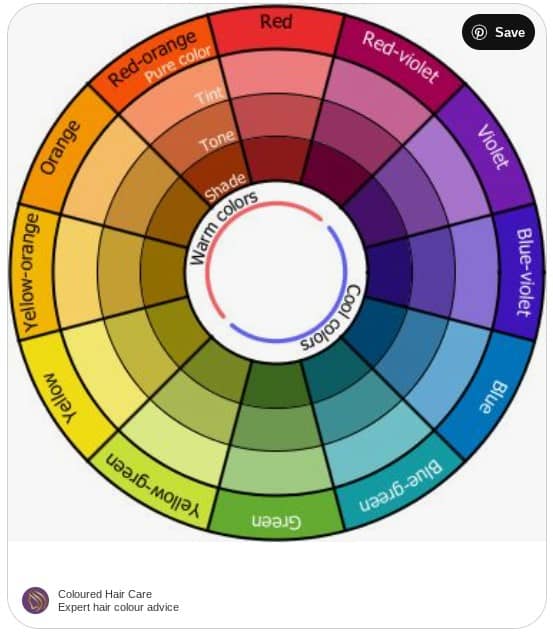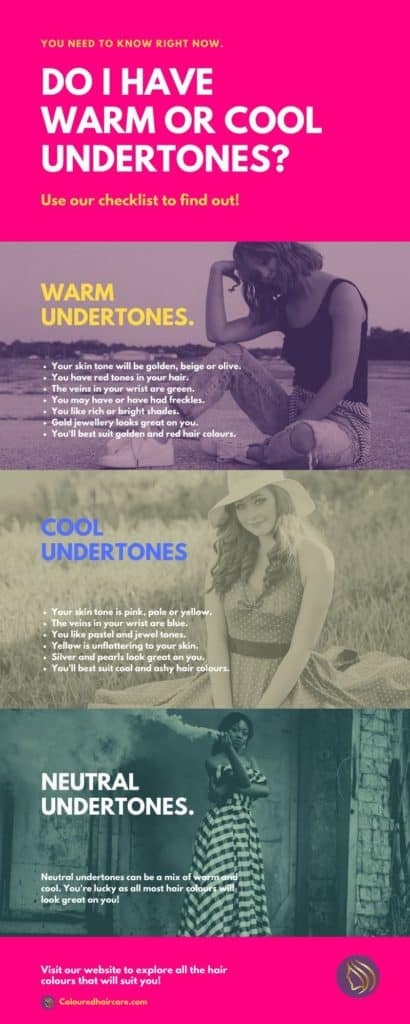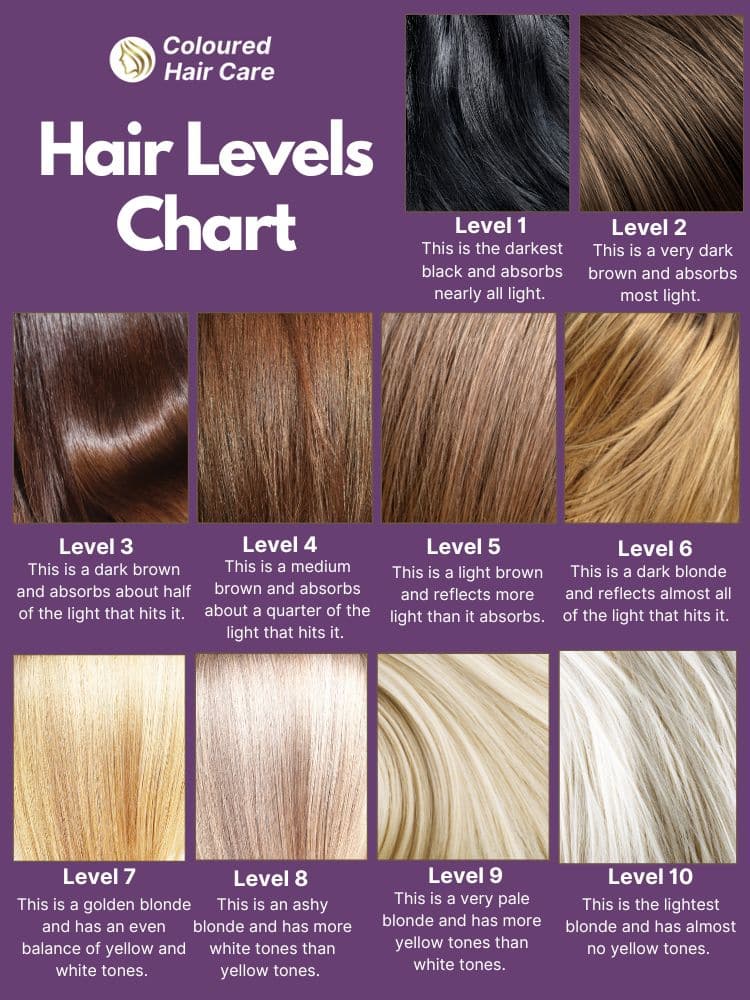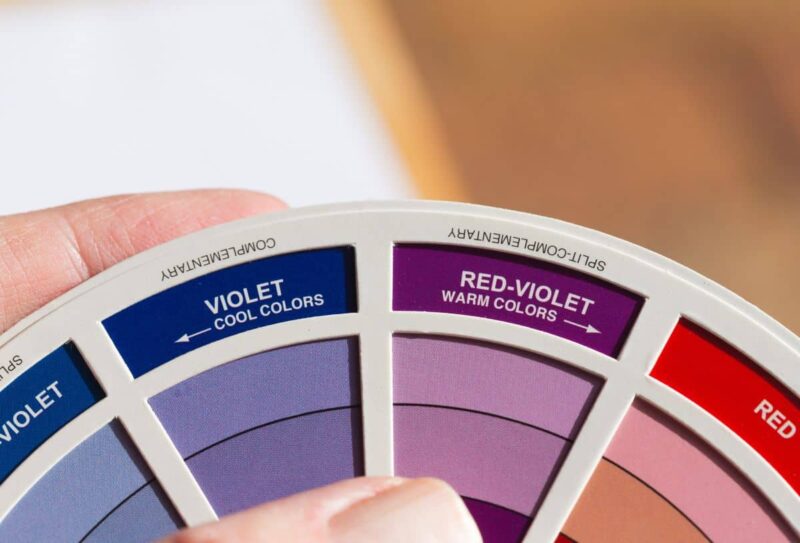Ah, the hair color wheel. A super useful thing of beauty for hair dressers and colorists everywhere and a thing of mystery for all us other folk.
Never fear. We’re here to tell you everything you need to know about the whirly wonder and how you can use it to get the best out of your hair color.
We know that choosing the right hue for you can be really hard. There are so many different shades and tones available that it’s easy to get confused.
Hair colorists have a secret weapon that they use every day to help their clients choose the best shades for them, but what if you’re not willing or able to visit your stylist?
The Hair Color Chart is here! This simple tool will make choosing the right shade of dye super easy.
If you’ve got dark brown hair, looking for an ashy blonde look or want something in between, this chart helps you pick the perfect color every time.

Table of Contents
- What is the hair color wheel?
- What is color theory?
- Primary and Secondary Colors: The Basics.
- Using complementary colors to create intensity.
- What is a color wheel’s purpose?
- How does the color wheel work for hair?
- How can I dye my hair using the hair color wheel?
- What hair color suits me?
- Which Hair Color Suits You?
- What color are my undertones?
- What are hair levels?
- What level hair color am I?
- Can I use the hair color wheel to bleach my hair?
- How can I tone my hair using the hair color wheel?
- What are hair toners?
- What is color toning shampoo?
- How do I use color toning shampoo?
- Hair color wheel FAQs
- What hair color cancels out orange?
- What color cancels out green hair?
- What color is ash?
- Parting words
What is the hair color wheel?

The hair color wheel chart is all about color theory. It’s what hair stylists use to work out the best tone and shade of hair color for you.
It consists of 12 colors of varying tones, shades and tints. And arranged is by warm and cool colors.
The hair color wheel explains everything you need to know about shade, tint, and hue. It groups hues into families – where colors like burgundy is part of the red hue family, or lilac is part of the pink hue family.
The wheel also shows the various hues that can be achieved by mixing hair colors. It’s often used to help find a new shade of dye, but it also works for those who have been wanting lighter or darker locks!
It’s a helpful tool for those who want to achieve their desired shade.
At its basic level, it’s great for working out which hair colors suit you based on whether you have warm or cool undertones and your hair color level.
It can help you find the right hair color to match your eye color, skin color and even the color of the clothes you should wear too!
What is color theory?
Colour theory is the study of how colors interact with one another.
It explores how certain colors complement each other and how they can be used together to create stunning effects.
By understanding basic principles like primary and secondary colors, complementary colors, and color intensity, you can become a master at using the color wheel for hair.
Primary and Secondary Colors: The Basics.
At its core, the hair colour wheel consists of three primary colors—red, yellow, and blue—and three secondary colors—green, purple, and orange—that are created when two primary colors are mixed together in certain combinations.
Primary colors cannot be created by mixing other hues; they exist on their own as components of all other hues on the spectrum.
Secondary colors are created from a combination of two primary hues. For example, red plus yellow yields orange; blue plus yellow yields green; red plus blue yields purple.
Using complementary colors to create intensity.
Now that we know about primary and secondary colors let’s talk about complementary colors—colors that are opposite each other on the wheel—and why they matter when it comes to creating stunning looks with your hair.
By using complementary hues next to each other (like green next to red), you can enhance the intensity of both shades so that they stand out even more vividly against one another.
This technique works especially well when working with lighter pigments such as blonde highlights or pastel pink accents because these pale shades need more depth to really pop against darker strands.
What is a color wheel’s purpose?
The hair color wheel is a handy tool for colorists everywhere. It’s an easy way to mix colors together on the fly or try out new shades.
Color guides can be used in conjunction with other color tools like hair color charts and hair levels and swatches to create a look that will make you stand out from the crowd.
Its main purpose is to help people understand the relationships between colors. That’s whether you want to change your hair color, tone it down or find the right color for you.
You don’t need any artistic ability to use it – all you have to do is look at the individual colors and see how they relate.
How does the color wheel work for hair?
Where it really comes into its own is when it comes to color correction and toning your hair.
That’s when a hair dye job has gone wrong or brassy tones like orange and yellow start showing through. And this is the sciency bit.
The opposite colors on the chart neutralize each other. So if your blonde or silver hair has started turning yellow or green, you’d need purple color to counteract it, and get it back to looking it’s best.
This is because purple is opposite to yellow on the hair color wheel, so they will neutralise each other. See?
And it works for all colors on the wheel.
If your brunette hair is turning orange, you’ll need blue pigments and cool tones to get rid of that unwanted brassiness. That’s because blue and orange are opposite colors. Simples!
It’s easy to understand when you know how!
How can I dye my hair using the hair color wheel?
Color theory can be a tricky concept to get your head (and hair!) around. Hair color is an art!
Truly understanding what color you will achieve by applying what tone is just that, art and a touch of science.
This video explains really well how to use the color chart to find the right color hair dye for you.
What hair color suits me?
Trying to figure out which hair color best suits you can feel like a complex task!
Understanding hair levels, undertones, and complementary colors, the hair color wheel should help you determine the perfect hair color for your complexion.
Start by evaluating the natural hair levels you have, then consider your skin’s undertone.
From there, use a hair color wheel to see what shades of hair best match with both hair levels and undertones.
You can also try out our What hair color suits me quiz below to help find the right shade for you!
Which Hair Color Suits You?
What color are my undertones?
Do you have warm tones or are you cool skin-toned? Not sure which undertones you have? You can use our checklist below to find out!
If you have cool undertones:
- You have a fair skin tone and a complexion that’s pink or pale.
- You will blush really easily!
- Jewel tones and pastel colors look great on you.
- Yellow is a color that you’d never wear as it washes you out.
- You have blue veins and not green veins in your wrist.
- Pearls and silver jewellery are very flattering on you.
If you have warm undertones:
- You have red or golden shades in your natural hair.
- Your skin tone and complexion is golden, tan or olive.
- You might have and used to have freckles.
- You have green color not blue color veins in your wrist.
- You suit wearing bright colors or richer shades better.
- Gold jewellery looks awesome on you.

What are hair levels?
Hair color levels (or hair dye level) is a numerical scale used to measure the depth of your hair’s pigment. The scale ranges from one (the lightest) to 10 (the darkest).
It helps determine which shades will best suit your natural color, as well as any future coloring services like highlights or lowlights.
What level hair color am I?
Figuring out your own personal hair color level doesn’t have to be complicated or intimidating at all. Here are some tips on how to work out your own hair color level:
- Take a look at your roots in natural light and compare them to the chart below. Generally speaking, if they match up with 1-2 then you’re light blonde; 3-4 is medium blonde; 5-6 is dark blonde; 7-8 is light brown; 9-10 is dark brown.
- If you have highlights or lowlights, take a look at the overall tone of those sections too – this will give you an idea on what tones would work best for future coloring services.
- If in doubt, don’t hesitate to ask your hairstylist for help – they should be able to tell you which number range best matches your current shade!

Can I use the hair color wheel to bleach my hair?
Have you ever tried to lighten your hair color but ended up frustrated with frustrating results?
While bleaching your hair isn’t recommended if you don’t know what you are doing, the color wheel can actually guide you to the perfect hue and balance of tonality.
Paired with the hair levels chart above, you can determine what volume developer you need to reach the level, color and hair color tone that’s best for you!
How can I tone my hair using the hair color wheel?
If you’re a hair dresser or colorist, there’s a lot more to hair color theory than looking at opposite colors on the chart.
Good colorists will look at things like your skin tones, your hair condition, your natural coloring, hair porosity and pigment to determine the right colors for you.
But for us, we can use the wheel to keep our hair dye color in check at home with color toning shampoo.
What are hair toners?
Hair toners are used as an after-color process to help maintain your color or correct any unwanted tones in your hair.
They typically bring out blue undertones in blonde hair, enhance reds for brunettes, and lighten up dark browns.
The best part about toners is that they do not change your base color but just help keep colors in check and as vibrant as you want them to be!
What is color toning shampoo?
Hair toning shampoos are color-correcting products that neutralise unwanted tones in your hair to keep your color on-point.
They are particularly good for blonde and bleached hair which can easily become too warm and brassy.
Professional hair toners are best applied in your salon. But for at-home toning solutions, toning shampoos are an excellent fix.
Toning shampoos and conditioners contain color pigments that correct your color.
The type of toning shampoo you need depends on the color of your hair now and the color you need to remove. This is where you can consult the good old charts to be sure. For example:
If your hair is dyed brunette, you need blue shampoo to get rid of orange tones and keep your hair cool. If your ombre or balayage hair is looking brassy, they’ll work for you too.
If you’re a blonde looking to neutralise brassy yellow tones, you need a Purple Shampoo.
For grey hair that’s showing signs of yellow brassiness, Silver Shampoos are best for you.
These are all opposite colors on the color wheel. You got it!
How do I use color toning shampoo?
Toning shampoos are easy to use. They cleanse your hair like normal shampoos while getting rid of dullness and color build up.
Some are quite strong and you may want to use gloves to stop them staining your hands. Be careful of your surfaces too.
In general, toning shampoos are more concentrated than toning conditioners but you can use both for the best results.
Be careful not to leave any toners in for too long. Although they won’t damage your hair, they can pretty drying. And coating your hair with too much toner can be hard to remove.
Do
- Give it a couple of weeks after coloring your hair before you use a toning shampoo. Because of the chemicals involved, your hair will be super porous and the color pigment in the shampoo could make it go patchy.
- Leave it in for a couple of minutes to really penetrate your hair.
- Rinse the shampoo out thoroughly.
- Make sure you use a good conditioner to keep your hair healthy, soft and in great condition.
- Experiment with using toning shampoos frequently or as an intensive treatment in between washes. Everyone’s hair will have different needs and some find the shampoos can be drying.
Don’t
- Don’t leave toning shampoos on your hair for too long – it can stain your hair. If you notice too much color in your hair after washing, you can use a good clarifying shampoo to remove it and rinse it out well.
- Don’t overuse toning shampoo. Find out what works for you and your hair. You can start by mixing it with your normal shampoo to test the strength.
- Don’t use the wrong color toning shampoo. Always consult the color guide to find the right neutralising color. If you get it wrong you might end up with a different color altogether! Yikes!
Hair color wheel FAQs
What hair color cancels out orange?
The colors that work best for canceling out orange are cool toned and ashy colors.
This includes shades of blue, purple, pink, and silver.
If you have an unwanted orange undertone in your hair, opt for a cool toned blonde like ash blonde or platinum.
To neutralize more intense shades of orange such as red or copper, go for a deep violet or blue-based color such as navy blue.
These colors will help to neutralize the orange tones and give your hair a more balanced look.
If you don’t want to switch up your hair color completely but just want to tone down the orange, try using a blue shampoo depositing shampoo or conditioner.
These products contain special pigments that will help to neutralize any unwanted brassy/orange tones in your hair without having to change the actual color.
This is great for those who just want to tone down their current color without having to make any drastic changes.
What color cancels out green hair?
One of the most popular ways to cancel out green hair is by using red hair dye.
Red dye works as an opposing color on the color wheel and will quickly neutralize any unwanted tones in your hair.
Another great option for canceling out green in blonde hair especially is purple shampoo or toner.
Purple shampoo works as an opposite tone of green (which is why it’s such a popular solution!) and helps reduce brassiness while neutralizing unwanted tones.
You can also use a toner instead of shampoo. A toner allows you to customize how light or dark your shade will be once applied – just make sure the purple hue isn’t too intense or else you’ll end up with grey locks!
What color is ash?
Ash hair is a cool-toned color that ranges from light greyish hues to deeper slate shades.
It’s usually used interchangeably with “gray” or “silver” colors but those colors tend to be warmer in comparison.
Ash hair has an icy and modern feel that can give you a unique edge over the crowd. Plus, it looks good on almost any skin tone!
Ash blonde and ash brown hair are all over our hot trending hair color lists for this year right now.
The key to finding the right shade of ash hair for you is understanding how different tones work with your complexion.
Generally speaking, those with fair skin should look for ashy colors with a warm tone; medium skin tones can handle both warm and cool undertones; and dark skin tones should look for cooler shades of ash with subtle hints of blue or purple.
Additionally, if you’re going from light to dark, consider adding highlights rather than opting for an all-over color change. Highlights will give depth and dimension to darker colors that would otherwise appear flat on your head.
Parting words
The Hair Color Wheel chart provides you with a comprehensive, at-a-glance guide to choosing the best hair color .
It takes into account your skin tone and undertone in order to provide you with accurate information about what colors will work for you.
This way, when it comes time to visit the salon or buy new cosmetics, you’ll know exactly what colors suit you. Good luck!

